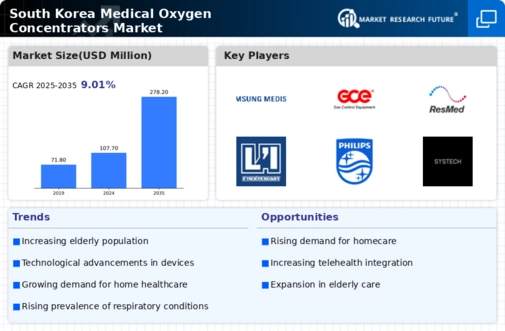Growing Geriatric Population
The demographic shift towards an aging population in South Korea is a significant driver for the medical oxygen-concentrators market. As the proportion of elderly individuals increases, the prevalence of age-related health issues, including respiratory diseases, is also on the rise. Current estimates suggest that by 2030, over 20% of the South Korean population will be aged 65 and older. This demographic trend is likely to lead to a higher demand for medical oxygen-concentrators, as older adults often require supplemental oxygen for chronic conditions. Furthermore, the increasing focus on geriatric care and the need for effective management of respiratory ailments among the elderly population are expected to further stimulate market growth. Consequently, the medical oxygen-concentrators market is well-positioned to capitalize on this demographic shift.
Rising Prevalence of Respiratory Disorders
The increasing incidence of respiratory disorders in South Korea is a pivotal driver for the medical oxygen-concentrators market. Conditions such as chronic obstructive pulmonary disease (COPD) and asthma are becoming more prevalent, affecting a significant portion of the population. According to health statistics, approximately 5.5 million individuals in South Korea are diagnosed with COPD, which necessitates the use of supplemental oxygen. This growing patient base is likely to propel demand for medical oxygen-concentrators, as they provide a reliable and efficient means of delivering oxygen therapy. Furthermore, the trend towards home healthcare solutions is gaining traction, as patients prefer receiving treatment in the comfort of their homes. Consequently, the medical oxygen-concentrators market is expected to expand as healthcare providers increasingly recommend these devices for managing chronic respiratory conditions.
Government Initiatives and Regulatory Support
Government initiatives aimed at improving healthcare access and affordability are playing a crucial role in shaping the medical oxygen-concentrators market. In South Korea, policies that promote the use of medical devices in home healthcare settings are encouraging manufacturers to innovate and expand their product offerings. Regulatory support for the approval and reimbursement of oxygen concentrators is also enhancing market growth. For instance, the Ministry of Health and Welfare has implemented programs to subsidize the costs of oxygen therapy for eligible patients, making it more accessible. This financial support is likely to increase the adoption of medical oxygen-concentrators among patients who require long-term oxygen therapy. As a result, the medical oxygen-concentrators market is expected to benefit from these favorable government policies and initiatives.
Increased Awareness of Home Healthcare Solutions
There is a notable shift towards home healthcare solutions in South Korea, which significantly influences the medical oxygen-concentrators market. As patients and caregivers become more informed about the benefits of home-based oxygen therapy, the demand for portable and user-friendly oxygen concentrators is likely to rise. This trend is supported by the growing emphasis on patient-centered care, which encourages individuals to manage their health conditions at home. Market data indicates that the home healthcare segment is projected to grow at a CAGR of 8.2% over the next five years. This growth is attributed to the convenience and flexibility that home healthcare solutions offer, allowing patients to maintain their quality of life while receiving necessary medical support. As a result, the medical oxygen-concentrators market is poised to benefit from this increasing preference for home-based treatment options.
Technological Innovations in Oxygen Concentrators
Technological advancements in the design and functionality of oxygen concentrators are driving the medical oxygen-concentrators market in South Korea. Innovations such as improved portability, enhanced efficiency, and user-friendly interfaces are making these devices more accessible to patients. For instance, the introduction of lightweight and battery-operated models has expanded the usability of oxygen concentrators, allowing patients to maintain mobility while receiving oxygen therapy. Additionally, features like smart connectivity and real-time monitoring are becoming increasingly common, enabling healthcare providers to track patient usage and adjust treatment plans accordingly. This focus on innovation is expected to attract a broader consumer base, as patients seek devices that align with their lifestyle needs. Consequently, the medical oxygen-concentrators market is likely to experience growth driven by these technological enhancements.






















Leave a Comment